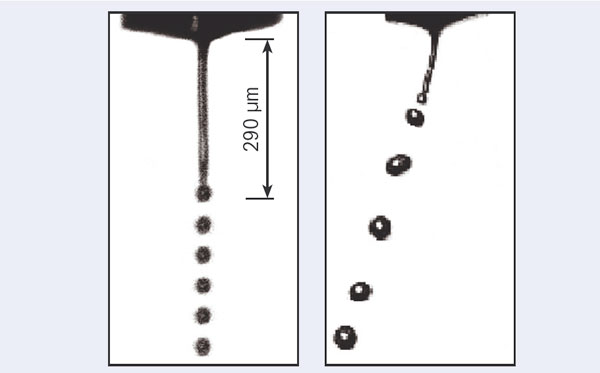Many technical and scientific applications, such as experiments with internal targets at particle accelerators, require the transport into an interaction zone of substances that are gaseous at room temperatures. At the same time, the pressure in the surrounding vacuum chamber must be kept as low as possible. One solution to this technological challenge are the so-called frozen-pellet targets, which provide fluxes of solid pellets produced from H2, N2, Ar or Xe, for example, with diameters in the 10 μm range. A new development not only provides more stable, narrow jets but also reveals some new phenomena in the process.

The central part of such a target is a “triple-point chamber”, where a jet of a cryogenic liquid is injected through a nozzle (with diameter roughly equal to the pellet diameter) into the same gaseous material close to triple-point conditions. Periodic excitation of the nozzle imposes oscillations along the jet’s surface; the jet then disintegrates into drops downstream of the nozzle when the perturbation amplitude becomes equal to the radius of the jet. The drops then pass through a thin tube into vacuum. As they do so, they cool by surface evaporation to below melting point, producing a regular flux of stable frozen pellets.
To produce narrow (diameters well below 1 mm), stable fluxes of pellets of the same size (monodisperse), the drop-production process must be carefully optimized and the production of satellite drops of varying size suppressed. Now a group from Forschungszentrum Jülich, Moscow’s Institute for Theoretical and Experimental Physics, and the Moscow Power Engineering Institute has done just this with a patented cooling method that suppresses unwanted nozzle vibrations.
The team’s technique has led to some surprising new findings. The breakup of jets of H2 and N2 reveals deviations from linear behaviour, indicating that Rayleigh’s well established theory formulated in 1878 is not appropriate for thin jets that exchange energy and/or mass with the surrounding medium. Another new phenomenon, for which there is not even a rudimentary theoretical explanation, are jet modes where the axial symmetry of the dynamics is lost (see figure 1).
Further reading
A V Boukharov et al. 2008 Phys. Rev. Lett. 100 174505.







